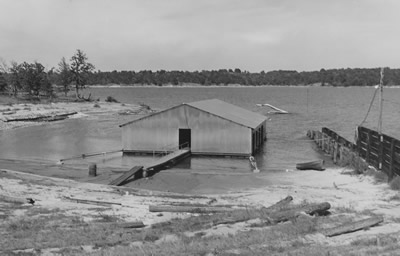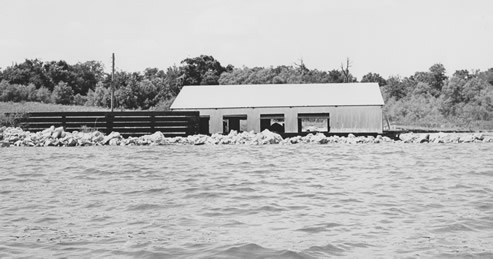

Horace Bliss: Now you have floating boat houses in a well protected harbor, how long did it take to get those developed?
Carl D. Riggs: Well, one of the major problems that we had during our first oh three or four years of operation, was getting classes in the sixteen foot boats and we usually would have three of those boats loaded up with students and there'd be four students per boat to go out on the lake. The wind is prevalent as you know in Oklahoma from the southwest and the lake is six miles wide in the southwesterly direction across from the Station over into Texas, so sometimes the waves coming in would be two and a half to three and a half feet high and it was not only getting quite wetting, but sometimes also dangerous to try to get a heavily loaded boat out from the ground, so we decided to develop a harbor that would be protected and we did this by getting the Corps of Engineers to come in and dredge out the boat house cove which you now know. And also to build a break water out of the creosoted poles and heavy concrete planks to protect that harbor. Unfortunately, we didn't reckon with the power of the waves and about two years after that break water was built the water was a little higher than usual, the waves smashed it down and exposed the floating boat house to heavy wave action. The first boat house was built--it was built, designed by Benny Schultz of the Physical Plant and was built by the University Physical Plant crew, welders, down on the swimming beach in front the of the Station, and it was built to float on fifty-five gallon steel drums. All the drums were in place and wired there so they wouldn't fall out and we thought we would have to wait until the following spring till the lake came up and floated the boat house free and then we'd take it around and moor it in the harbor. Well, again as luck would have it, right after they finished the boat house it started to rain, and within two weeks after it was built the lake came up enough to float it away and we put it in the boat house where it has been ever since; or rather in the boat harbor where it has been ever since.
Horace Bliss: Was that rock sea wall that extends around the sides always there?
 |
 |
Carl D. Riggs: No. I mentioned the heavy wind, the wave action that we had, that those waves and the annual fluctuation of water level caused the bank to become badly eroded so that when we first opened the Station there was about a three foot bluff and within three years that was about a fifteen foot bluff and the land had eroded back some thirty feet from the original line. It was obvious that if we didn't stop this, it would or could actually eat away most of the Station ground, so in 1956 when the lake was at its lowest level, there was a large ledge of limestone exposed to the south and to the east of the Station and I talked a man from the Hercules Powder Company into coming in and showing Clyde Johnson and me how to shoot dynamite and how to use a drill and after he taught us then we drilled that rocky point and dynamited it--loosened the rock and built the sea wall from that rock. It was quite that simple because that low rain-fall period was disastrous to the local farmers and Raymond Gary had now become Govenor of the State and was looking for ways to aid farmers around the State and so he gave the Station, out of his continguency fund something between ten and fifteen thousand dollars which was a fair amount of money in those days to hire those local farmers to take that rock and to build that sea wall. So we did the dynamiting, we hired a local contractor to load and haul the rock, and the farmers to put it in place and they built the sea wall plus the stone break water that now protects the boat harbor and that I think will last forever because some of those rocks, as you know, are three and four feet square. So we added another boat house because we got additional boats and larger boats so the boat harbor now has two boat houses in it and protected again by the sea walls that were built in 1956.
|
||||||||||